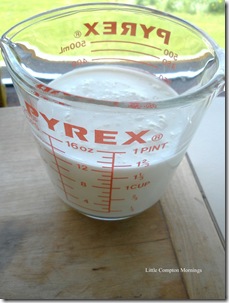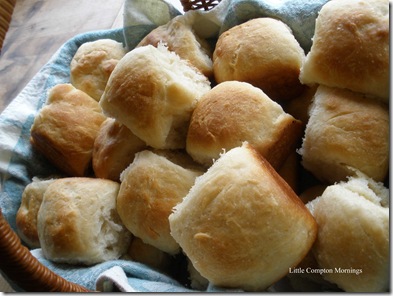 My fondness for sour milk in baking, as expressed here , here, and here, extends to its close relative, buttermilk. The buttermilk available to us in stores is “cultured” buttermilk, which is different from what I would call “true” buttermilk—the milk or liquid that remains after butter is churned. Some of you may remember this kind of buttermilk from your youth. It was about the consistency of today’s skim milk, was quite acidic, and often had tiny flecks of butter in it. It was a natural low-fat product.
My fondness for sour milk in baking, as expressed here , here, and here, extends to its close relative, buttermilk. The buttermilk available to us in stores is “cultured” buttermilk, which is different from what I would call “true” buttermilk—the milk or liquid that remains after butter is churned. Some of you may remember this kind of buttermilk from your youth. It was about the consistency of today’s skim milk, was quite acidic, and often had tiny flecks of butter in it. It was a natural low-fat product.Today’s cultured buttermilk, on the other hand, is a soured milk product. It is thicker than whole milk, with a taste similar to sour cream but with lower fat—think of low-fat yogurt—making it a good substitute both for sour cream in many baked goods and also for sour whole milk. If you can obtain raw milk, you can make your own cultured buttermilk; the process involves leaving raw milk out to clabber through natural fermentation, removing some and adding more fresh milk to it, and repeating the process at least once more to achieve a thick, sour liquid. It will be different from and higher-fat than the commercial variety, though, which begins with skim or low-fat milk, is injected with bacteria, is both pasteurized and homogenized, and usually contains added salt and sometimes commercial stabilizers, as does some commercial sour cream. Some producers even add fake or real butter flakes; check your label to see what is actually in your store or dairy’s cultured buttermilk. Most “natural” or organic varieties will not contain added stabilizers.
It is the acidity in buttermilk that makes it so attractive for baking. It imparts not only tang but tenderness. Buttermilk is therefore commonly used in cakes, pancakes, waffles, and breads (it makes excellent biscuits and white bread). But it has other uses. It is a great base for low-fat salad dressings and soups, and makes a fabulous, old-fashioned custard-type pie. You can use it to thin mashed potatoes or to add edge to a chocolate sauce or frosting. And of course it can be drunk like any other milk.
When using buttermilk for quick-type baking (i.e., non-yeast), you just need to be sure to use baking soda—about ½-1 teaspoon per cup of flour—to react with the acid to produce carbon dioxide gas to leaven the product and smooth out the acidity. With this addition, you can generally substitute buttermilk for regular milk in most recipes. Always bake your batter or dough immediately after combining your soda and buttermilk or you will lose the powerful but brief burst of leavening action.
Quick Buttermilk Rolls
These are an easy, light, soft, everyday dinner roll—there is only a short kneading and one quick rise. Not as rich as most dinner rolls, they are perfect for people watching their cholesterol, especially if you brush them with margarine instead of butter, as they are made with oil as well as buttermilk and contain no egg. Makes 2 dozen.
2 packages yeast
1 T sugar
¼ cup warm water
1 ½ cups buttermilk

2 T sugar
1 ½ tea salt
½ cup vegetable oil
4 cups a-p flour + up to ½ cup for kneading, sifted or not
1 T melted butter or margarine
Preheat oven to 400 F. Generously grease bottom and sides of a 13x9 baking pan.
In a large bowl, combine yeast, 1 T of sugar, water. Set aside ‘til bubbly.
Heat the buttermilk slowly until just warm; add it to the yeast mixture, followed by the salt, 2 T of sugar, and oil. Stir. Gradually add the 4 cups of flour and baking soda; sifted is preferable, but it’s not a big deal. Cover with a towel and set aside for about 10 minutes.
Put another ¼ cup flour on a board, and turn the dough out; it will hold together but be sticky. Flour your hands and, with the aid of a scraper, knead for about 5 minutes or until the dough is elastic and coherent but still tacky; add additional flour if necessary, but keep the dough soft.
Shape the dough into 24 balls, about 2-2 ½" each, and place them, touching, in the pan. Cover with plastic wrap sprayed lightly with cooking spray, and let rise for a half-hour. Brush with melted butter or margarine and bake for about 12-14 minutes, or until light golden brown. Let cool in the pan on a rack for about five minutes, then turn them out and pull them apart. Serve warm with salted butter, or use for pulled pork or brisket sandwiches.



1 comment:
Gorgeous rolls. I think I might try them when I cook for the seniors( I have a senior dining thread on Egullet).
Post a Comment